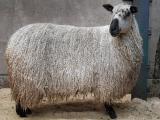
|
Tan SheepTan sheep are famous for their fur with long curled hair. The wool of Tan sheep is soft, light and puffy, with long and even fiber, suitable for making high-grade blankets, shawls and scarves. Tan sheep are raised in the desert and semi-desert regions of China. |

|
Targhee SheepThe Targhee is one of America's youngest breeds. It was developed in 1926 at the U.S. Sheep Experiment Station in Dubois, Idaho, from Rambouillet, Columbia and Corriedale crosses. The Targhee derives its name from the Targhee National Forest on which the experiment station's flock grazes in the summer. The forest was named for a chief of the Bannock Indians who had lived in the area in the 1860's. |

|
Teeswater SheepTeeswater, a longwool sheep from Teesdale in the County of Durham, located in Northern England, have for almost 200 years been bred by farmers in that area of the north. Until the 1920's, the breed was comparatively rare, but now they are to be found in almost every part of the U.K. |

|
Texas Dall SheepThe Texas Dall has no relation to the Alaskan Dall. It is a hybrid, a cross between domestic sheep (Rambouillet and Barbados Blackbelly) and the European Mouflon. |

|
Texel SheepThe Texel originated on the Isle of Texel off the coast of the Netherlands early in the nineteenth century. They became available to U.S. sheep producers in 1990 when they were released from quarantine at the U.S. Meat Animal Research Center in Clay Center, Nebraska, where they were evaluated for their potential in crossbred lamb production. |

|
Tong SheepTong sheep originate from Mongolian sheep. They are able to withstand unfavorable environmental conditions and are found in the high plains of the northern Shaaxi Province of China, where the average temperature is 13°C and annual precipitation is 520 to 600 mm (20-24 in). Their wool is carpet wool. Wool production is low. |

|
Tsigai SheepTsigai sheep originated in Southeast Europe, where they are raised for meat and milk. There are many variations of the breed. |

|
Tukidale SheepTechnically, the Tukidale is a not a new breed of sheep, but rather a Romney sheep carrying the T gene for hair. The breed originated on M.W. Coop's property in New Zealand from a ram born November 26, 1966. The ram possesed the T gene, which is dominant. The T gene is responsible not only for producing the specialty carpet-type fleece, but also the formation of horns in the in the male and, to a lesser extent in females. |

|
Tunis SheepThe Tunis is one of the oldest sheep breeds, said to have roamed the hills of Tunis and parts of Algeria in North Africa prior to the Christian era. The American Tunis evolved from a number of importations of fat-tailed sheep from Africa and the Middle East that were crossed with established European breeds to improve the breed's meat characteristics. |

|
Turki SheepAfghanistan is home to many of Central Asia's most unique breeds of sheep that are particularly well-adapted to the local conditions and highly valuable commercially. The most notable is the largest breed of fat-rumped sheep, the Turki. |

|
Tyrol Mountain SheepThis breed is found in Tyrol of Austria and Bolzano of Italy. It is a coarse wooled breed, belonging to the Lop-eared Alpine group, which is kept for meat production. |